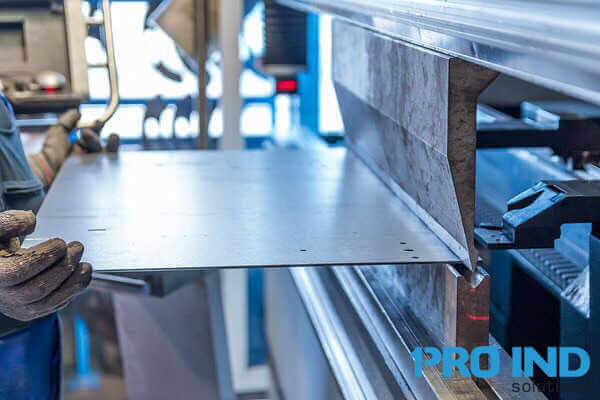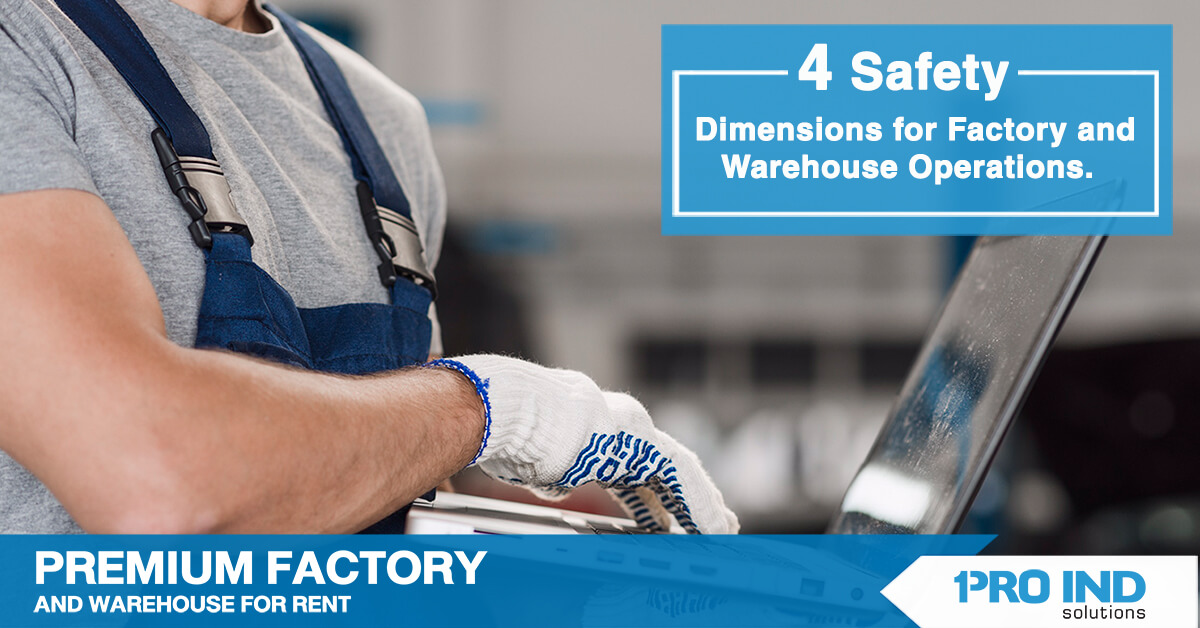4 Safety Dimensions for Factory and Warehouse Operations
4 Safety Dimensions for Factory and Warehouse Operations
In successful industrial enterprises, there are many factors that entrepreneurs and plant operators need to consider. Safety and work hazard preventions in your factory are vital elements of a successful operation. This article helps factory and warehouse managers become aware of associated risks in your work and offers various ways to mitigate these problems.
There are many aspects related to safety regulations and practices in factories and warehouses. This article would illustrate the four essential safety aspects of your plant operations, and they can reinforce a consistent and systematic method to meet the standard safety requirement.
Factory Safety Standards in 4 areas that Entrepreneurs should Know
1. Thermal safety standards
Heat Level in the factory
The level of heat inside the factory can have a direct impact on the safety standards in factory settings. Generally, you should avoid letting the internal temperature become too high. The acceptable norm for a present working environment is 38 degrees Celcius or less since this is analogous to average body temperature. If your factory exceeds this bearable temperature, management needs to address this issue. Your plant does not currently satisfy the thermal safety requirement.
Tools and measures
Also, your facilities should have tools for temperature measurements since exposure to high heat can pose a severe threat to occupation safety. When some of your manufacturing processes demand exposure to high heat, you should equip your employees with appropriate protection tools and equipment. Besides, it would be beneficial if you have emergency protocols when the employees' body temperatures become too high. You can promptly and safely deal with your staff in the event of emergencies.
Rest when the body temperature exceeds 38 degrees Celsius
You should consistently monitor the body temperature of your staff. When you find your employees' temperature exceeds 38 degrees Celsius, you should request your employees for immediate rests. Employees should not resume work until their temperature returns to normal.
Important notification
In certain manufacturing areas, which have high heat exposure, you should provide warning signs relating to associated risk dangers. For example, you should post warning signs and notifications, such as the heat source, so that your employees can take precautionary steps when they work in the area. It would also be fitting if you have strict protocols when employees work in such areas.
Safety measures
For employees working with temperatures above 45 degrees Celsius, the operations should have stringent work guidelines. To ensure proper safety, the staff should wear high-temperature protective appeals, a suitable helmet, masks, and googles throughout the work period. This specialized clothing can safeguard against high heat.

2. Sufficient Lighting for Safety Standards
Another vital element in creating a safe working environment is adequate lighting for your operations. The safety standards stipulate proper illumination of all of your processing areas. To ensure safe and pleasant working conditions, you can follow these basic guidelines for lumination levels.
The standard lighting level for normal operations
For typical manufacturing processes requires standard visual focus, the conventional lighting for your factory and warehouse should have the illumination intensity of at least 50 lux. Grinding, moving, and packing activities are examples of this type of operation.
Lighting for storage areas
The storerooms and warehousing space for your materials and products should also have a lighting level of at least 50 lux. Similarly, areas such as balconies and stairs, are prone to accidents, and they should have a lighting intensity of at least 50 lux.
Work processes that require a small lighting resolution
For work operations that require a little more lighting, the intensity should be greater than 100 lux. Examples of these types are milling, typical manufacturing processes, and simple assembly lines.
Work processes that require a medium lighting resolution
Specific jobs, such as garments, sewing, and sewings, demand higher visual concentration. For these manufacturing processes, the lighting resolution should be at least 200 lux, so that employees can adequately perform their tasks.
Work processes that require a high lighting resolution
Finally, specialized jobs demand a very high intensity of lighting so that employees can smoothly perform their tasks. In these working zones, there should be plenty of light. The lighting intensity in these areas should be more than 300 lux. Examples of these work areas are product testing labs, product inspection areas, machine repairments, and metal pressing works.
Work processes that require an ultra-high lighting resolution
These specialized works require the most light. Since their work demand an ultra-high level of visual attention, the factories should provide the lighting intensity of more than 1,000 lux. Some examples of this category would include dark color sewing, assembly of minuscule parts, and jewelry works.
Lighting for outdoor areas
For outdoor areas, including walkways, roads, and outdoor storage areas, the natural sunlight is sufficient to carry out the works. For nighttime operations, the outside areas require the lighting intensity of a mere 20 Lux.
3. Noise safety standards

Less than 7 hours a day
For the noise aspect in a safe working environment, the primary determinant is the work duration, since prolonged exposure to loud noises can lead to impair the employees' hearing abilities. Typically, suitable working hours should be less than 7 hours per day.
Between 7-8 hours a day
For employees who have to work between 7-8 hours daily, the plant manager needs to check whether the noise level within your premises does not exceed 91 decibels.
Working hours more than 8 hours a day
For employees who have to work more than eight hours continuously daily, the factory owners must ensure your factory's noise level does not exceed 80 decibels.
Noise within the establishment
Another vital element in assessing your noise safety standards within a factory is the overall sound level within the establishment. Following the universal work safety standards, the entire noise level must not exceed 140 decibels. Employees can face severe long-term hearing problems when the noise level exceeds this amount.
4. Safety standards for chemical particles
Atmosphere
As a responsible factory operator, you have to ensure that the chemicals and particles within the air is within the general safety standards. Thai law has explicitly defined a proper amount for the factory. If you are uncertain about this issue, you can conveniently consult the environmental engineers or the relevant Ministry of Industry office.
Duration
Moreover, the Thai regulation also specifies the length of work duration for employees, so that your factory would not expose your employees to chemical particles over an extension of time. A prolonged period of exposure can adversely affect your employees' heat.
Chemical Density.
If your factory has certain areas with a high level of chemical concentrations, you should consult with the experts. Thai authority also clearly determines the appropriate amount of chemicals. When your factory exceeds the specified amount, your factory can create serious health problems for your employees.
Dust particles
Finally, a vital element affecting your factory and warehouse's air quality is dust particles. Employees can face severe respiratory problems when there is considerable dust in the air. In general, you should ensure that the dust level within your factory and warehouse does not exceed the standard set by law.
This article has illustrated the crucial safety aspects of your factory and warehouse operations. We hope our article can help you apply appropriate safety measures so that you can improve your manufacturing standards as well as create a happy, engaging workplace for your staff.
If you are interested in renting a high-quality factory or warehouses in Thailand, please feel free to contact us anytime. Our properties have complete functions, and they are in excellent locations. Plus, we support our customers with free repair services throughout the leases as well as a full range of customer support services. Our projects have high-security systems with 24-hour security guards, and CCTVs.
Sources:
https://www.chi.co.th/article/article-1186/
https://www.youtube.com/watch?v=X9ANJz1mnKw
You might also like.
- 8 Things to Know About the Revised Thailand Factory Act The new Factory Act came into effect on October 27th, 2019. The government encouraged investment in the industrial sector...
- There are 8 Convincing Advantages of Renting a Factory or a Warehouse. When entrepreneurs establish their businesses or expand their operations, choosing the appropriate factory o...
- 8 Things to Consider in a Factory and Warehouse Rental Contract in Thailand Factory rental and Warehouse rental have become a prominent choice for business people today. Because of...
- Five innovations that PRO IND factories and warehouses for rent use for heat prevention. Global warming is getting worse every year, and Thailand is greatly affected. It has advers...
- There are 5 essential reasons why we should focus on heat prevention inside the factory and warehouse. The hot weather in Thailand does not seem to lessen. From statistics, the te...
- Five reasons examine why the Samut Prakan province did not flood when Thailand's Big Flood in 2011 occurred. When there was a big flood in 2011, Samut Prakan Province was virtual...
- 5 reasons why renting a factory or a warehouse in the Bangna-Trat area is an excellent idea for conducting your business in Thailand. Many people may wonder why they should rent fa...
- 4 Taxes Related to Factory Rentals and Warehouse Rental Currently, many entrepreneurs and business people are renting factories and warehouses for their business operations because...
- 6 Advantages of Setting up your Factory and Warehouse in Samut Prakan When deciding on the area to base your factory or warehouse, surely, Samut Prakarn would come up as one of the...
- 6 Factors in Choosing an Ideal Rental Factory or Warehouse for Your Business. We present six vital factors in determining the right factory or warehouse for your business. Picking ...
- 6 Things to Know about Establishing a GMP Food Factory in Thailand There are strict rules and standards imposed by the government and relevant authorities to adhere to the quality ...
- The Difference between 3-Phase Factory Electricity and 1-Phase Ordinary Electricity What is the difference between 3-phase and 1-phase electrical systems? Which model is suitable f...
- 5 Things you should Know Before Renting your First Warehouse. As your business prospers, you need substantial space to store your products and raw materials. Selecting your first w...
- 10 Features of Excellent Rental Factory and Warehouse Layouts Factory and warehouse layouts are critical to entrepreneurs and business owners' successes in their production. Rentin...
- 6 Advantages of uPVC Windows and Doors for Factory and Warehouse Many customers, who have visited our factory-and-warehouse-rental projects, are delighted with the quality of our d...
- 5 Typical Scams in Factory and Warehouse Rentals Recently, entrepreneurs and business owners are preferring to rent factories and warehouses rather than owning these properties the...
- 3 Benefits of Epoxy Floor Coatings for Factory and Warehouse. Epoxy floor coating is a synthetic rubber that is produced by the chemical reaction between Epoxy and Polyamine combin...
- 10 Effective Ways to Prevent Factory and Warehouse Fires The warehouse and factory buildings are essential to all types of operating businesses. Frequently, they are the businesses...
- 5 Practical Ways to Save Energy in your Rental Factory and Warehouse Modernized factories and warehouses nowadays are undergoing a drastic change: many factories and warehouses are...
- 7 Insights on Lean Management to Reduce Costs and Increase Profit for Factory Operators The lean system (LEAN) is an ideal practice for factory operations. It helps decrease avoida...
- 4 Advantages of PU Roofs for Rental Factory and Warehouse PU Foam insulation is an excellent material for omitting heat transfer into our rental factory and warehouse areas. It com...
- Key Points on Thailand's BOI: Clear Implications for Factory and Warehouse Operators Board of Investment of Thailand (BOI) has the core responsibility in promoting foreign direct i...
- 7 Benefits of Aluminum Composite, and Because of these Reasons, We use it for our Rental Warehouses and Factories. Presently, in the construction materials sector, we frequently no...
- 8 Significant Expenses Related to a Factory and Warehouse Rental in Thailand Renting a factory or a warehouse when you establish your company in a new country is a vital step in yo...
- 8 Questions to Ask When Choosing Warehouse for Rent in Thailand Selecting a suitable warehouse rental is imperative to business success. The current business landscape demands stra...
- Thailand’s Various Rental Warehouse Types and their Purposes This article would distinguish the various warehouse for rent types in Thailand. We can identify a warehouse facility a...
- Warehouse Management Techniques. How to Practice Warehousing Activities Efficiently for your Business? In manufacturing businesses, warehousing creates substantial financial impact...
- 5 Factors to Consider when Renting a Factory or Warehouse in Thailand Selecting a high-quality rental warehouse or factory is a fundamental step in a successful business establishm...
- 4 Necessary Steps for your Factory and Warehouse Relocation Factory and warehouse rentals have become the current viable choice for business operators because this choice offers ma...
- 5 Things to know about Thailand’s Cold StorageWarehouse for Rent A cold storage warehouse is a warehouse that controls the temperature in the storage area, and the appropriate temp...
- 5 Negotiation Tips for Thailand’s Factory and Warehouse Rental Contracts Selecting a factory and warehouse for rent is an integral part of your business success. In Thailand, succe...
- What are the Similarities and Differences Between the GMP and HACCP Standards in a Factory in Thailand? Two crucial, global standards for food manufacturers are the GMP and HACCP s...
- 7 Things to Know about Establishing a HACCP Manufacturing Facility in Thailand The HACCP system stands for Hazard Analysis and Critical Control Point System. Food production employ...
- 6 Highlights on Thailand’s Factory Clean Rooms Cleanrooms are an essential part of manufacturing sites, which demands high levels of cleanliness. The cleanrooms enable your product...
- 4 Insights on Thailand’s Bonded Warehouse Currently, rental bonded warehouses in Thailand have gained much popularity among business people. Bonded warehouses are especially useful...
- 3 steps to rent a factory and warehouse in Thailand and everything you should know to help you prepare when looking for factories for rent and warehouses for rent. Nowadays, factor...
- 7 crucial factors in choosing a factory and warehouse location in Thailand 7 crucial factors in selecting a rentalwarehouseor factory location in Thailand. This article is relevant...
- 5 things you need to know when choosing a factory for rent and a warehouse for rent in Thailand Quality factories or warehouses for rent can boost the tenant's company image and cr...
- 7 Advantages of Renting Warehouses in Pro Ind Warehouse Park 4 Project Renting a warehouse is a crucial step in managing business inventory, whether for small or large businesses....
- 8 Special Services When Renting a Factory, or Warehouse with Pro Ind Solutions Co., Ltd. At Pro Ind Solutions Co., Ltd., we prioritize the quality of our rental factories, and our ...
- 6 Advantages of Renting an Elevated Warehouse for Rent Choosing an efficient warehouse for rent is a crucial factor that significantly impacts the success of business operations to...



.png)
.png)

